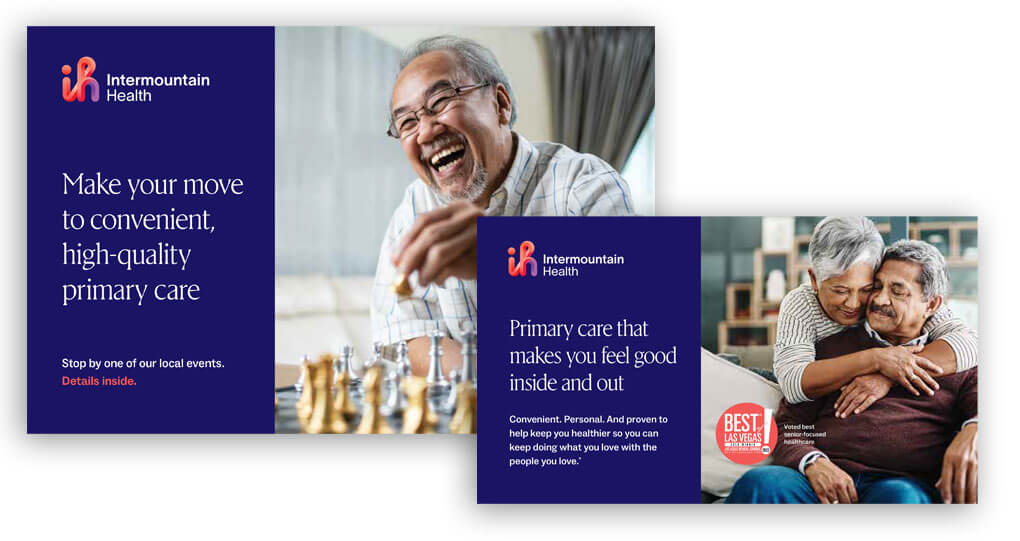5 Ways to Use Photography to Drive Response Rates
Sean Clark Boomer Marketing, Creative That Sells, DRTV, Digital Direct Marketing, Direct Mail, Email Marketing, Health Care Marketing, Insurance Direct Marketing, Medicare Marketing, Response Marketing, Trends and POV, Action Brand - Action MarketingPhotography helps distinguish your brand in the marketplace, presents visuals your target audience can relate to, and evokes appropriate emotions to complement your message. When you choose images wisely, you can quickly connect with your prospects and help encourage them to act while enhancing your overall brand.
So how do you ensure the imagery in your Medicare marketing isn’t doing your brand and your new membership goals a disservice? Here are some ways to make the best use of stock photography and explore possible alternatives.
5 tips to win over your 65+ audience with photography
1. Align with your brand
Your brand guidelines (or standards) should give you a road map to follow when making photography and graphic selections.
If you don’t have comprehensive brand guidelines, reach out. We’ve created guidelines for brands, specific campaigns, and new health plan launches. Documenting your stylistic preferences is key to establishing consistent creative across all channels and building brand recognition and affinity in the marketplace.
Respect your brand guidelines — down to the smallest details
“Posed photography is the best!” … said no brand guideline ever. And yet, regional and national plans still fall back on smiling 65+ couples staring wistfully into the distance to appeal to their audience.

These examples from Intermountain Health’s acquisition campaign show peer photography in relatable, real-world scenarios.
If your guidelines specify “natural, candid imagery,” understand what that means. Is it lighting? Is it depth of field? Is it people who are untouched or caught mid action? Match those traits to your stock image searches and you’ll find great choices.
Brand guidelines are all about the details — from cropping approaches to colored overlays and supergraphics. When you select photography that brings all those details together — suddenly, your marketing feels like it belongs to just your plan. It promotes recall of your brand campaign, and prospects will be able to separate you from Plan X.
2. Say “Yes!” to proprietary photography
Despite the potentially intimidating price tag, a custom photo shoot can pay you back in spades. Depending on the size and scope of your direct marketing efforts, there could be little to no price difference in the cost of stock photography versus a shoot. The upside to a shoot? Prospects won’t confuse you with another entity using the same model or location.
When determining potential locations and props for your photo shoot, think about your brand and the benefits you’re selling. If you’re marketing a Medicare Advantage plan that offers an allowance for eyeglasses, for example, consider photographing a person picking out new frames.
Increasingly, research shows the more personal, hyper-local, and relevant your marketing is, the more likely a prospect is to engage. That goes beyond messaging and into imagery. Having geographical references and talent that precisely reflect your audience can make a big difference in how you’re perceived.
When considering cost, think practically
Can you use your custom library of images in key pieces and fill in the gaps with less expensive stock? This can keep talent fees down and limit your shoot to one day. Is broadcast or video in your marketing mix? Arrange to capture stills before, after, or in between set ups. You’ll benefit from the cohesion between your DRTV spots and other on and offline materials.
When our use of photography helps a brand distinguish itself in the marketplace, presents realistic situations, and evokes the right emotions, we know we’ve surpassed ‘canned’ creative and created something truly unique and engaging.
3. Get real
When I worked on my first Medicare health plan campaign nearly 15 years ago, the options for photography were dismal. Despite the flood of retiring Baby Boomers, stock photography hadn’t caught up yet. Everywhere I looked I saw the same toothy couple, walking on a beach with perfect hair and impossibly smooth skin.
Fast forward to today — the volume and quality of stock photography is amazing! That said, the same models pop up time and time again: Man with trim white beard, or mature woman with pixie cut holding a to-go coffee. You know who I mean. Well shot? Sure! But also overused.
When Katie Maule wrote her post on marketing to seniors, she touched on why authenticity is important. When selecting or reviewing your photography, be considerate of your audience. Go beyond stereotypes and contrivances. Not everyone over 65 hikes mountains. Not everyone over 65 has a spouse or grandkids.
4. Look them in the eye
Eye contact in branding has fallen out of fashion. Thanks to stale portraits of half-smiling men in sensible sweaters, some brand guidelines have explicitly forbidden eye contact!
That said, direct eye contact — a face turned straight to the viewer — can be a powerful stopping point for a casual skimmer. Imagine standing at your mailbox … as you flip through all the postcards from landscapers and window installers, you see a peer looking up at you. It’s enough to make you stop and scan the headline or offer, right?
If your brand allows it, there are very good options for photos with people making direct eye contact that aren’t cringe-worthy. We’ve created award-winning campaigns that centered around lively 65+ adults, looking right at the viewer. Direct eye contact immediately gets a person’s attention, conveys interest, and can evoke trust and credibility.
5. Invite the community
Medicare plans do well when they represent the audience they’re trying to engage. But Medicare-eligibles often rely on family, friends, and the community to thrive. So don’t just stick to peer photography.
Even moving from a single model to a group photo can dial up the community feel — and the desire to enroll. If “everyone” seems to be part of a certain plan, you’ll be left out if you don’t enroll, too.

Multigenerational images can also help boost engagement. Many seniors are grandparents, or have grandnieces, nephews, and even neighborhood children who are part of their lives. When featured appropriately, kids add warmth and energy to even the most benefit-driven sales kit.
Pets? Absolutely. Pet ownership has several positive health benefits to seniors, and over half of adults over 50 have at least one pet. Add a sleeping cat or a dog fetching a ball into your lifestyle mix to broaden the appeal of your design and add an element of joy that only a picture of a pet can provide.
Activate your brand
If a picture is worth a thousand words, how much value do you place on imagery in your marketing?
My goal is to engage consumers. Pique their interest. Acknowledge their pain points. Provide solutions and show them a clear benefit to taking an action — right now.
At DMW, we do our best work when we align our marketing efforts with the strongest aspects of a brand. When our use of photography helps a brand distinguish itself in the marketplace, presents realistic situations, and evokes the right emotions, we know we’ve surpassed “canned” material and created something truly unique and engaging.
Reach out to chat with us about how we can help you connect with your audience, drive action, and reach your goals — while continuing to build awareness and strengthen your brand position for next year and beyond.